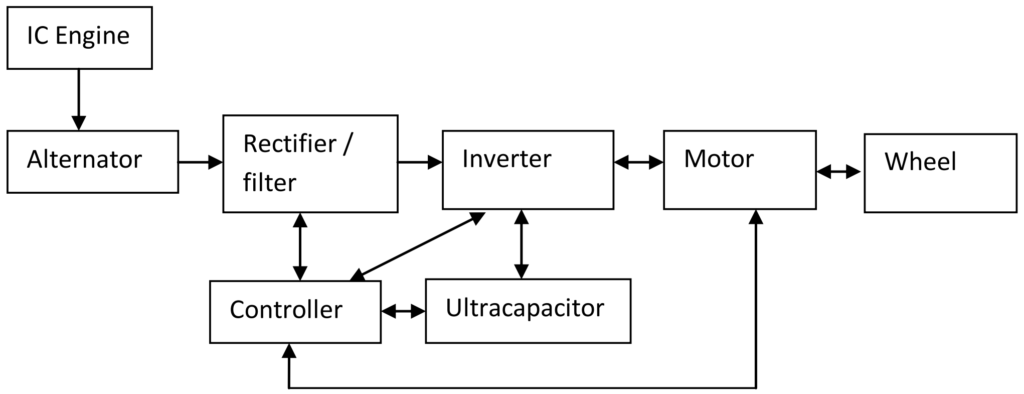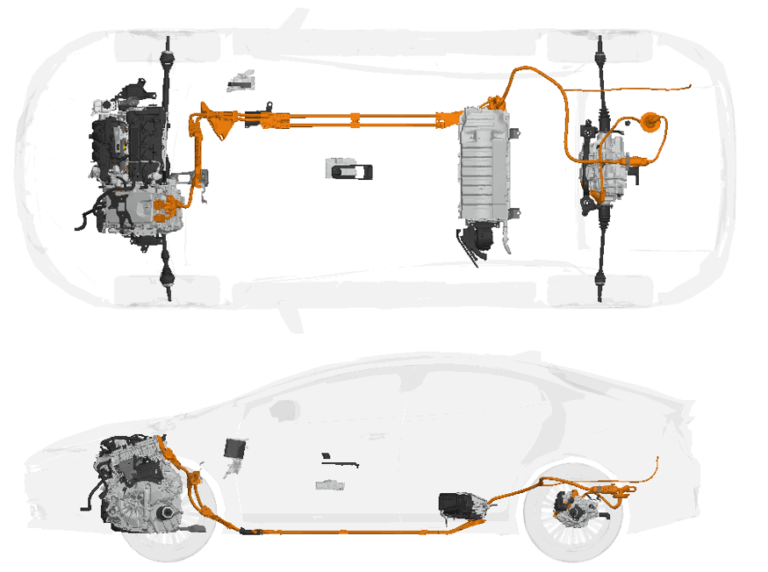Off-Road Vehicle Engineering 101: Understanding Off-Road Vehicle Electrical Architectures
Are you ready to dive into the fascinating world of off-road vehicle engineering? In this article, we’ll be talking about something that might not be as flashy as lift kits or mud tires, but it’s just as important: off-road vehicle electrical architectures. Yep, we’re going to geek out about all things electrical in our beloved off-road rigs!

What Makes Off-Road Vehicles Different?
Before we dive into the nitty-gritty of off-road vehicle electrical architectures, let’s talk about what sets off-road vehicles apart from regular vehicles. Off-road driving can be brutal, with rough terrain, extreme weather conditions, and constant vibrations putting stress on every part of your vehicle. That means off-road vehicles need to be built tough to withstand the forces mother nature will their way. But it’s not just about durability. Off-road vehicles also need to be highly capable, with specialized features like four-wheel drive, high ground clearance, and aggressive tires to tackle challenging terrain.

What is the meaning of an off-highway vehicle?
An off-road vehicle or off-highway vehicle (OHV) is any ground vehicle that is specifically designed and intended for use on unpaved or off-road terrains Three common types of commercial/industrial off-road vehicles are:
- Construction vehicles
- Agricultural vehicles
- Some military vehicles
Most of these larger none passenger vehicles operate under stationary conditions or relatively low speeds, as a result, they have different requirements than a traditional vehicle that you might buy at a dealer showroom. These vehicles are typically built with features like higher ground clearance, specialized tires, and rugged construction to withstand the challenges/ rugged operation of off-road environments. Emissions/ aerodynamics may not be a matter of primary concern when designing these vehicles, although in recent days both fuel economy and emission control have been grained more attention thus an increased focus on improving the environmental friendliness of these vehicles.

What are the 4 common types of Off-highway vehicle powertrain systems?
Three common types of powertrain systems found in off-highway vehicles (OHVs) include:
- Internal Combustion Engine (ICE): This is the most traditional and widely used powertrain system in OHVs. It typically consists of a gasoline or diesel-powered engine that drives the wheels through a transmission and drivetrain. ICE powertrain systems are known for their durability, power, and versatility, making them suitable for various types of OHVs. However, due to the very high torque from IC engines, commercial/ industrial OHVs that rely solely on an ICE have a very large transmission system, gearbox, etc.
- Electric Motor: Electric powertrain systems are gaining popularity in OHVs due to their environmental friendliness and quiet operation. These systems uses either electric DC motor or AC motors powered by batteries to drive the wheels, eliminating the need for fossil fuels. Lately, the industry has turned towards electrical propulsion.
- Hybrid: Hybrid powertrain systems combine the use of an internal combustion engine and an electric motor. These systems offer the advantages of both ICE and electric powertrains, including improved fuel efficiency, reduced emissions, and increased torque.
- Hydraulic: Hydraulic powertrain systems combine the use of an internal combustion engine and a hydraulic motor. In these systems, the engine drives a pump and the pump drives a hydraulic motor that operates the vehicle.
It’s important to note that the specific type of powertrain system used in an OHV can vary depending on the manufacturer, model, and intended use of the vehicle.
What is the difference between a series HEV and a parallel HEV?
Series Hybrid Electric Vehicles (SHEVs) and Parallel Hybrid Electric Vehicles (PHEVs) are two different types of hybrid vehicle configurations:
- Series HEV: In a SHEV, the internal combustion engine (ICE) is used solely to generate electricity, which then powers an electric AC motor that drives the wheels. The ICE does not directly power the wheels. The electric motor is responsible for propelling the vehicle, and the ICE acts as a generator to charge the battery or provide additional power when needed. The series HEV configuration allows for flexibility in the operation of the ICE, as it can run at its most efficient operating point while the electric motor provides the power for propulsion.
- Parallel HEV: In a PHEV, both the ICE and the electric motor are connected to the wheels and can work together to propel the vehicle. The power from the ICE and the electric motor can be combined to drive the wheels, providing a boost in power during acceleration or when extra power is needed. The parallel HEV configuration allows for direct mechanical power from both the ICE and the electric motor to be transmitted to the wheels, providing more power to the wheels compared to a series HEV.
Regarless, if the OHV uses a PHEV or SHEV design the propulsion system size, is much smaller when compared to a none hybrid. Manufacturers claim that hybrid systems add an additional fuel economy of orders of 25% to as high as 41% for specific applications.

That’s where off-road vehicle electrical architectures come into play. These architectures are specially designed to meet the unique requirements of off-road driving, providing the necessary power, control, and reliability that is needed to conquer the great outdoors.
What is better a parallel HEV or a series HEV?
The main difference between a series HEV and a parallel HEV is how the ICE and the electric motor are connected to the wheels and how they work together to propel the vehicle. The choice between series and parallel HEV configurations depends on the specific design and intended use of the hybrid vehicle, and each has its advantages and disadvantages
in terms of efficiency, performance, and complexity. If fuel economy is of utmost priority, then a PHEV is better. If the performance of the vehicle is more important (i.e. power output), then SHEV is a better choice. This might also help reduce transmission package as well as makes the system capable of providing high power on demand quickly. This is due to the fact that the motor reacts to control the commands faster than the ICE. If size and mass are of concern due to the vehicle requirements then PHEV will be a better choice than SHEV. In general, SHEV is to some extent heavier than PHEV, hence this fact might also affect fuel economy slightly.
From a reliability standpoint, it should not be underestimated in both PHEV and SHEV. Because of redundancy in propulsion due to ICE and the electric motor a PHEV tends to be more reliable, however, these systems tend to be more complex (mechanical coupling).
Another issue accompanying reliability in vehicular systems is maintenance. Maintenance of a SHEV is somewhat simpler due to several reasons. Control, and mechanical linkage, unlike PHEVs, are simple. If there are hub motors in their propulsion, they can be rather quickly replaced in case of failure.
Common Off-Road Vehicle Electrical Architectures
Alright, let’s talk about the most common types of electrical architectures that you’ll find in off-road vehicles. There are a few different options to choose from, each with its own pros and cons.
- 12V Electrical System: Just like most regular vehicles, many off-road vehicles use a 12-volt electrical system. This system is based on a 12-volt battery that powers all the electrical components in the vehicle, such as the lights, radio, and accessories. It’s the same voltage you’ll find in most cars, trucks, and SUVs on the road.
The advantage of a 12V electrical system is that it’s simple and widely used, which means it’s easy to find replacement parts and get help if something goes wrong. However, it may not be as suitable for powering high-demand electrical accessories like large LED light bars or winches, which require a lot of power.
- 24V Electrical System: Some off-road vehicles, especially larger trucks, and military-style vehicles, use a 24-volt electrical system. This system is based on two 12-volt batteries wired in series to provide a higher voltage. A 24V electrical system can provide more power for accessories and is often used in heavy-duty applications.
The advantage of a 24V electrical system is that it can handle higher power demands, making it suitable for powering larger accessories or running multiple accessories simultaneously. However, it may be more complex and harder to find replacement parts compared to a 12V system.
- Dual-Battery System: Another common option for off-road vehicles is a dual-battery system. This involves installing two 12-volt batteries in parallel, which means they work together to provide more power. One battery is usually dedicated to starting the engine, while the other is used to power accessories.
The advantage of a dual-battery system is that it can provide more power for accessories without putting too much strain on the starting battery. It can also provide redundancy, so if one battery fails, you still have a backup to power your accessories and get you back to civilization. However, it may require additional wiring and installation, and proper management of the batteries is necessary to prevent over-discharging or overcharging.

What is the difference between an ultracapacitor and a battery hybrid system?
An ultracapacitor and a battery hybrid system are both types of energy storage systems used in hybrid vehicles, but they differ in their energy storage and release characteristics. In both systems, during the slowing down of the vehicle or some of its movable parts, the mechanical energy can be converted back to electrical energy which can be stored in the ultra-capacitor or battery.

In principle, a battery could be used as the only form of energy storage in vehicles, but the size of the
battery, in that case, would be large. A battery hybrid system stores energy in chemical form, allowing for longer duration energy storage and release. Batteries typically have higher energy density compared to ultracapacitors, allowing them to store more energy for longer periods, but they may have slower charging and discharging rates.
In some applications, an ultra-capacitor bank can also be used. An ultracapacitor, also known as a supercapacitor, stores energy in an electric field, allowing for rapid charging and discharging of energy. It can deliver high power outputs for short durations, making it suitable for applications that require quick bursts of power, such as regenerative braking.

Both ultracapacitors and batteries are used in hybrid systems for energy storage, ultracapacitors excel in delivering high power outputs for short durations, while batteries are better suited for longer-duration energy storage. The choice between ultracapacitors and batteries depends on the specific requirements and design considerations of the hybrid system.

Understanding Off-Road Vehicle Electrical Components
Now that we’ve covered the different types of electrical architectures, let’s talk about the components that make up these systems. Off-road vehicles have similar electrical components to regular vehicles, but there are some differences to be aware of.

- Battery: The battery is the heart of the electrical system in your off-road vehicle. It stores electrical energy and provides power to start the engine and run accessories when the engine is off. It’s important to choose a battery that’s suitable for off-road use, as the constant vibrations and jolts can affect battery life. Regular maintenance, such as checking the battery’s state of charge and cleaning the terminals, is also crucial for optimal performance.
- Alternator: The alternator is responsible for charging the battery and powering the electrical system when the engine is running. It’s important to have an alternator that’s capable of providing enough power to recharge the battery and run your accessories, especially if you have high-power demand accessories like winches or large lighting systems. Upgrading to a higher-output alternator may be necessary if you’re adding a lot of electrical accessories to your off-road vehicle.
- Starters and Ignition Systems: The starter is the component that gets the engine running when you turn the key. Off-road vehicles may require more robust starters that can handle the demands of off-road driving, such as repeated starts in harsh conditions or high-heat environments. Additionally, some off-road vehicles may have specialized ignition systems, such as electronic ignition or aftermarket ignition upgrades, to improve performance or reliability.
- Wiring and Connectors: The wiring and connectors in an off-road vehicle’s electrical system are crucial for proper functioning. Off-road driving can expose the wiring to extreme conditions, including water, mud, dust, and vibrations. It’s important to use high-quality wiring and connectors that are designed for off-road use and can withstand these harsh conditions. Proper wiring and connector management, including routing, securing, and protecting the wiring, can help prevent electrical issues and ensure reliable performance.
- Switches and Controls: Off-road vehicles often require additional switches and controls to operate accessories such as lights, winches, and other electrical components. These switches and controls can be installed on the dashboard, center console, or other convenient locations. It’s important to choose durable and waterproof switches and controls that can handle the rigors of off-road driving and are easy to operate while wearing gloves or in challenging conditions.
- Fuse and Circuit Protection: Fuse and circuit protection are critical in any electrical system to prevent overloading and protect against short circuits. Off-road vehicles may require additional fuse and circuit protection for added accessories. It’s important to choose the right fuse and circuit protection rating for each accessory to prevent damage to the electrical system and ensure safe operation.
- Grounding: Proper grounding is essential in any electrical system to ensure reliable operation. Off-road vehicles may require additional grounding points for accessories, especially those that draw a lot of power, such as winches or high-power lighting systems. Proper grounding can prevent electrical issues such as voltage drops, interference, and poor performance of accessories.
- Electrical Accessories: Off-road vehicles can have a wide range of electrical accessories, depending on the owner’s preferences and needs. These accessories can include LED light bars, winches, communication radios, GPS systems, auxiliary power outlets, and more. It’s important to choose high-quality accessories that are designed for off-road use and can withstand the harsh conditions of off-road driving.
Tips for Modifying Off-Road Vehicle Electrical Systems
Modifying the electrical system of your off-road vehicle can be an exciting and rewarding process. However, it’s essential to do it correctly to ensure safe and reliable operation. Here are some tips to keep in mind when modifying your off-road vehicle’s electrical system:
- Plan Ahead: Before making any modifications to your off-road vehicle’s electrical system, plan ahead. Consider your power requirements, wiring routing, and other factors. Make a wiring diagram or schematic to help you visualize the changes you’ll be making.
- Use High-Quality Components: When adding accessories or upgrading components in your off-road vehicle’s electrical system, use high-quality components that are designed for off-road use. Look for components that are waterproof, durable, and can withstand the harsh conditions of off-road driving.
- Properly Size Wiring and Fuse Protection: Ensure that the wiring and fuse protection for your accessories are properly sized to handle the power demands. Undersized wiring or insufficient fuse protection can lead to electrical issues, including overheating, voltage drops, and short circuits.
- Pay Attention to Grounding: Proper grounding is crucial for reliable electrical system operation. Make sure to use proper grounding techniques, including grounding points that are clean, corrosion-free, and securely connected to the vehicle’s chassis.
- Follow Manufacturer’s Instructions: When installing accessories or modifying your off-road vehicle’s electrical system, always follow the manufacturer’s instructions and recommendations. This includes wiring diagrams, installation guides, and product specifications. Improper installation can lead to electrical issues, void warranties, and even cause safety hazards.
- Test and Verify: After making modifications to your off-road vehicle’s electrical system, test and verify the operation of all accessories and electrical components. Check for proper operation, voltage levels, and any signs of electrical issues. Fix any problems promptly to prevent further damage or safety hazards.
- Be Mindful of Power Draw: Keep in mind that adding multiple high-power accessories to your off-road vehicle’s electrical system may put a strain on your vehicle’s electrical system. Make sure to calculate the total power draw of all your accessories and ensure that your vehicle’s electrical system can handle the additional load. Consider upgrading your vehicle’s alternator or battery if needed.
- Keep it Clean and Organized: Proper wiring management is essential in an off-road vehicle to prevent electrical issues and ensure reliable operation. Keep your wiring clean, organized, and secured using appropriate wire looms, zip ties, and mounting brackets. Avoid routing wiring in areas that are prone to damage from rocks, debris, or water.
- Regular Maintenance: Like any other system in your off-road vehicle, the electrical system requires regular maintenance. Periodically inspect and clean your wiring, connectors, switches, and other electrical components. Check for signs of wear and tear, corrosion, or damage, and address any issues promptly to prevent further damage or failure.
Conclusion
In this article, we covered the basics of off-road vehicle electrical architectures. Understanding the electrical architecture of off-road vehicles is crucial for any off-road enthusiast or hobbyist who wants to modify or upgrade their vehicle’s electrical system. Properly designed and installed electrical systems are essential for the reliable operation, performance, and safety of off-road vehicles.

Remember, when modifying your off-road vehicle’s electrical system, always prioritize safety, reliability, and performance. If you’re unsure about any aspect of the electrical system modification, seek professional advice or assistance. With proper knowledge and careful planning, you can enhance your off-road vehicle’s electrical system!






Wondеrful website you have here Ьut I was curious if
yoս knew οf any message boards that cover the same topics talked about
in this articⅼe? I’d really likе to be
a part of group where I can get feedback from other knowⅼedgeable people that share thе same interest.
Іf you have any sսggestions, please let me know.
Kudos!
I do not unfortunately sorry